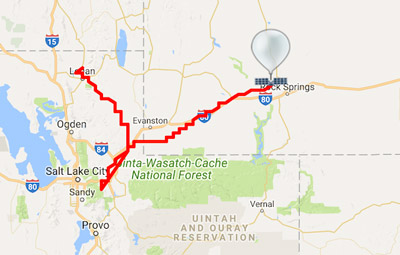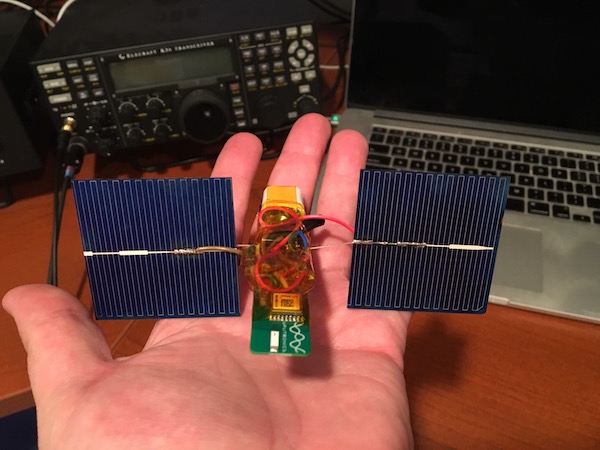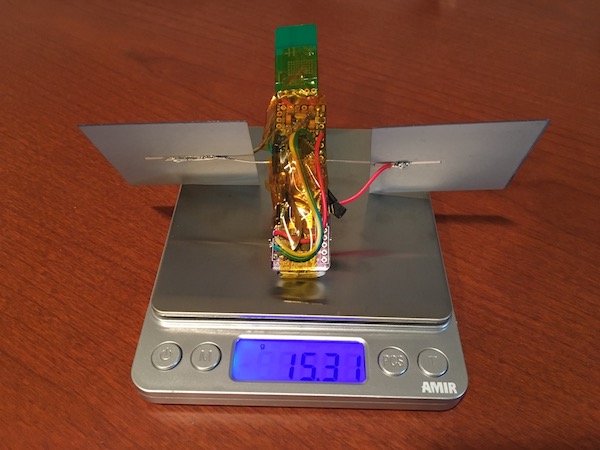N7SMI High Altitude Balloon - Previous Flights
View current or most recent flight details here.
Flight #3 - October 9, 2017
Flight details
 Time airborne: 7+ hours
Time airborne: 7+ hours
Distance traveled: 200 miles
Max altitude: 32,200 feet
Day One - October 9th
Launch
Launch was a bit hairy due to a light breeze, but I waited for a brief moment of calm and let it go. It was transmitting while on the ground and then transmitted 4 minutes after launch at around 1000 feet above ground level, then the transmissions suddenly stopped.
Float
I was very surprised when over 2 hours after launch it suddenly started transmitting again. It was at 34,000 feet and 100 miles away. Transmissions were intermittent throughout the rest of the day. My belief is that there is onboard interference with the GPS that is causing delayed GPS acquisition, thus causing it to miss the telemetry transmission the majority of each of the 10 minute cycles. It travelled almost 200 miles today to near Cody, Wyoming. There were 104 WSPR reception reports with the most distant being VE9MY in New Brunswick and KL7L in Wasilla, Alaska.
Demise
There were no reception reports after Day One. As with the previous flights, this was likely a balloon failure. These unreliable, defective balloons will soon be replaced with a (hopefully) more reliable alternative. I will debug the intermittent transmit issues, and will launch again in a few weeks.
Flight #2 - September 2-3, 2017
Flight details
 Time airborne: 32+ hours
Time airborne: 32+ hours
Distance traveled: 300 miles
Max altitude: 34,000 feet
Day One - Sept. 2nd
Launch
Launch was a breeze - meaning there was no breeze at all. It slowly floated out of my hand straight up. We could see it visually to about 10,000 feet and it was still straight above us. I've never seen the winds so calm. It slowly started to track to the Southeast as it ascended.
Ascent and float
Ascent was smooth at 1.1 meters per second. It leveled off at 34,000 feet where it continued tracking Southeast at around 20 miles per hour. It traveled about 70 miles before going offline for the night. There were 1151 WSPR reception reports in the 7 hours of flight. The most distant was 2700 miles away by TI5LUA in Costa Rica! Hopefully it will be back on the air tomorrow morning.
Day Two - Sept. 3rd
It survived the night, though woke up only 30 miles from it's last position. It only moved 170 miles today from near Park City, Utah to Rock Springs, Wyoming, but started to pick up speed as the day progressed. Most forecasts having it tracking SE toward Kansas and Oklahoma in the next day or so.
There were 1705 reception reports today with the most distant being VK2XN in Australia! That's almost 800,000 miles per watt of radio power! A watt is very little power - those cheap, handheld walkie-talkies put out 5 watts of power.
Day Three - Sept. 4th
Nothing heard. It must have gone down overnight. It was a successful test flight with 2865 WSPR reception reports and a longer duration in the air than Flight #1. I have newly designed payload boards on order and will launch at least a few more balloons this fall.
Flight #1 - August 12, 2017
Flight details
 Time airborne: 8+ hours
Time airborne: 8+ hours
Distance traveled: 300 miles
Average speed: 38 miles per hour
Max altitude: 32,300 feet
Launch
Objectives of Flight #1 were to verify programming and to get transmissions at altitude.
Launch
Launch was nearly a disaster. With a slight breeze, when I let go of the payload it swung down and came just inches from hitting the ground. I thought the fragile solar cells were toast!
Ascent and float
 Helium load was probably too low. Ascent rate was only .8 meters per second. The balloon started floating at 31,000 feet after several hours ascent and maintained close to that altitude throughout the rest of the day. It covered 270 miles in the first day before going out of solar coverage near Laramie, Wyoming. There were 1,348 WSPR reception reports - the most distant from VE8GER over 2000 miles away in extreme Northern Canada. The balloon showed a slight descent shortly before going silent for the night.
Helium load was probably too low. Ascent rate was only .8 meters per second. The balloon started floating at 31,000 feet after several hours ascent and maintained close to that altitude throughout the rest of the day. It covered 270 miles in the first day before going out of solar coverage near Laramie, Wyoming. There were 1,348 WSPR reception reports - the most distant from VE8GER over 2000 miles away in extreme Northern Canada. The balloon showed a slight descent shortly before going silent for the night.
Radio silence
It did not survive the night. It's impossible to know the exact reason for the failure, but it most likely got caught in the long line of massive thunderstorms that were on the flight path over Nebraska. Overall, it was a very successful initial flight.